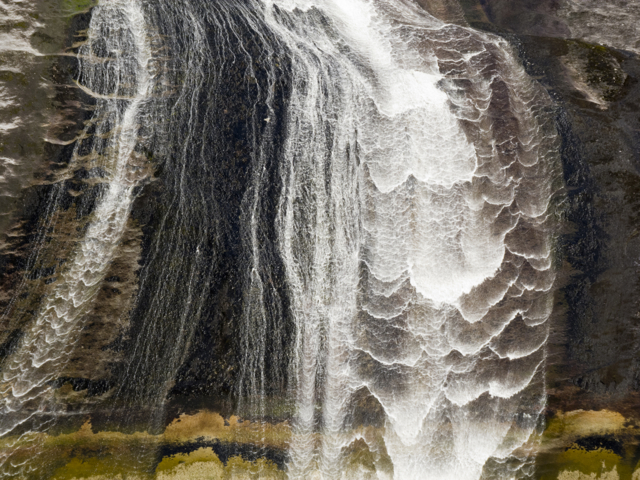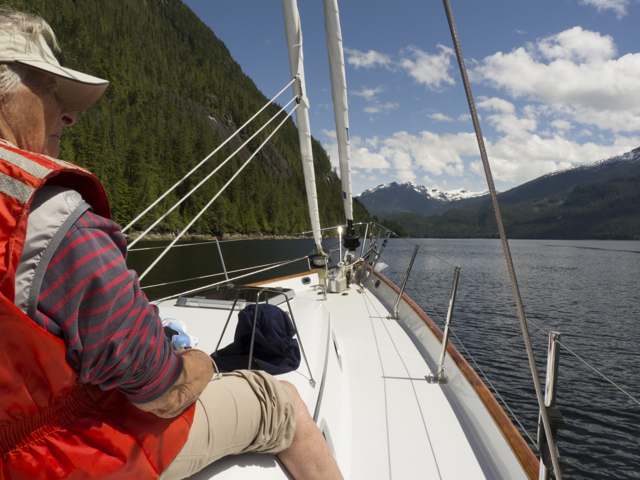6 July 2012 Viner Sound/Tribune Channel/Bond Inlet and the Ahta River/Sargeaunt Passage/Knight Inlet/Tsakonu Cove
After days of rain and fog, summer suddenly arrived in the Broughton, hot and bright. We stayed moored to the Forest Service buoy in Viner Sound for a couple of days, rowing, exploring, fishing, and visiting with our friends Rick and Dawn who were nearby on their boat, Kalagan. We wrote, cleaned and aired the boat, and watched for bears. We didn’t see any. Zephyr, at the Salmon Coast Field Station in Echo Bay, had told us they would be shy because American trophy hunters had been permitted to take four bears in the area and one had been shot from a boat in Viner Sound; the bears, she said, were probably no longer going to feel safe around boats. We didn’t really blame them. It seems unsporting to shoot at a bear on shore from a boat, especially when they have become accustomed to boats, and don’t consider them dangerous. If you want a bear pelt you ought to have to struggle through the steep, overgrown terrain—get your feet wet, scramble over fallen trees and boulders, risk getting lost, put your own life on the line—not fire through a scope at bears casing the beach for clams.
Dawn suggested we circumnavigate Gilford Island. We looked at the charts—that would take us into the Tribune Channel by a spectacular falls, up into Bond Inlet, where the Ahta Valley watershed that Billy Proctor fought to preserve from logging is found, then back into the Tribune Channel towards Knight Inlet, a deep fjord that runs way up into the mountains of the BC mainland and drains the Kinaklini River. It seemed like a grand idea.
We were up early the next day and already it was bright and sunny, even hot. We weighed anchor, zipped open the cockpit coverings–our dodger and bimini–and turned up into the Tribune Channel—named we discovered, after yet another 19th century British gunship. Clearcuts scarred the mountainsides, but still the beautiful world sparkled: snow clung to the mountaintops, dolphins leapt through our bow wake; now and then we crossed paths with other boats.
At Lacy Falls, which is indeed spectacularly patterned and frilled, we nudged in towards the cliff as closely as possible for a photo shoot. The cliff wall is steep and smooth, allowing the water to glide down its surface in cascading loops and drops.
And right next to the falls, a fish farm. The water around it was green, perhaps indicative of an algae bloom.
We continued along up the Tribune Channel and into Bond Sound, where we aimed for the Ahta River Valley at its head. In Heart of the Raincoast, we read that one day Billy Proctor came dashing into a gathering in Echo Bay shouting that the lumber companies were going to clearcut the Ahta River Valley and Bond Sound, the last old growth forest in the Broughton and a crucial wild salmon spawning grounds. Thanks to a fierce fight, for now at least, the Ahta Valley is safe. Because this was the southernmost unlogged river valley on the coast, we wanted to see it. What did old growth forest look like anyway?
Bond Inlet was covered in trees but they did not seem huge. In fact, much of the inlet had been logged. Striping the green slopes were steep gashes of bare rock—mudslides in the wake of cutting, or naturally occurring events? We didn’t know.
The sky was blue, the water bluer, the mountainsides green, the mountaintops still snowy, waterfalls everywhere, range upon range of mountains receding in the distance. You felt you could go forever in such a landscape on such a day, and never tire of the clouds and water, the colours and heights.
The Ahta River estuary is at the head of Bond Sound– a sandy, flat, green marshy area, inhabited by many waterfowl. Karin identified a red-throated loon taking flight; we also saw guillemots, gulls, eagles, rhinoceros auklets, and tiny marbled murrelets. The shore shelved too steeply for us to anchor comfortably there, but the morning was so still and the place so bucolic, that we just cut the engine and drifted quietly before the shore. We would have liked to spend the night there, and dinghy up the river at high tide towards the snow-covered mountains looming above. Another time perhaps.
After a lunch adrift, we left Bond Inlet and continued through Tribune Channel in the heat, dodging logs and other flotsam—it’s rather a trip to sunbathe underway, while surrounded by snow-covered mountains, but you do have to keep a sharp lookout, so as not to run into logs spinning by in the current.
By afternoon, we’d arrived at the edge of narrow, shallow Sargeaunt Passage . We turned into it, past several young seals who had hauled out of the water and were sunning themselves on a floating log. They looked up at us lazily but did not move. We continued threading through the passage, past a hurly-burly camp built of half-wrecked, jerry-rigged old boats, and then an enormous fish farm (stink of manure and thick green algae in the water).
We crossed Knight Inlet—gazing longingly up into its splendid heights—and turned into Tsakonu Cove for the night.
Tsakonu Cove is recovering from a huge forestry operation. Small deciduous trees run along the shore, and the water in the cove is full of logging buoys, logs and other debris. The base of the cove was very shallow, drying out at low tide. We launched the dingy and rowed along the shore at high tide, going up a small stream into the cool, fresh, damp woods.
We found that water beneath the hull of the boat looked and behaved strangely; it was unlike anything we’d ever seen before. Two or three feet below the surface was a layer of algae seven or eight feet deep—it looked, in fact, as if we were anchored in impossibly shallow water. We tried to stir the algae with a paddle, but it didn’t move. The paddle didn’t even dent it, nor could we brush it aside or peer through it. Was this the remainder of the forestry operation, or—as it seemed it might be—the gathering in this corner of algae from a bloom caused by the high sulphide levels around the nearby fish pens? We now knew that for every cycle of 500,000 open pen farmed salmon grown out, more than ten jumbo jet loads of fish waste falls to the sea floor rendering it anoxic and unable to support marine life. The average farm is over a million fish now, and in the Broughton there are 22 open pen salmon farms. That is quite a number of jumbo jets of fish waste year upon year in the coves where there are fish farms.
The days are very long in early July north of 50 degrees north latitude. The sun beat down on us with a ferociousness more like you’d expect in the tropics than rainforest BC. We were all alone in our cove, so we stripped down on the stern for a sun shower, then began to barbecue some lingcod. Overhead, a woodpecker rattled away. As we nursed our sundowners, a black bear lumbered out of the woods, stepped carefully across a fallen log, and dropped onto the beach. The bear crawled below the tide-line and began flinging huge rocks aside, digging beneath them for crabs and clams and other tasty sea creatures for supper, sometimes almost disappearing into the hole where a rock had been. Finally, we’d seen our first bear. –In fact, we have hesitated to mention it, worried that it will become a target for another coward’s trophy hunt.
When the tide changed, another strange thing happened: we spun around and around, four times, and all of the logs and debris in the cove gathered and rafted together with us. Then, as the current shifted, the logjam broke apart, the logs all spun away, and we stayed just where we were, in the middle of the cove.
The next morning as we weighed anchor and turned away from Knight Inlet and towards Mound Island, then Port McNeil, we joked that we could not take another inlet just now. The previous day had been crammed with wonder, beauty and peculiar spots of devastation. Glory and sorrow wrapped up in one big spectacular package. We ached to see more.
We promised ourselves we’d come back to Knight Inlet—the place known as dzawali in the Kwak’wala language–and brave its remoter reaches sometime. Boaters headed up the Inlet are advised to travel with a companion because once one winds up into the mountains, there are no communications, no real services, big winds, big tidal changes, strong currents and lots of grizzly bears. And if you’re stuck or in trouble, it is a very long way back—125 kilometers, in fact. But someday we’ll brave that–what a promising adventure it seems!



















Magnificent! so CANADIAN EH!
I feel so at peace reading you and looking at the photos , simply beautiful.
I felt sad when you wrote, “worried that it will become a target for another coward’s trophy hunt.” It is against the law in BC to hunt black bear without taking the edible portions of the carcass. What you describe would be poaching, do you think that is common?
Hi Rob, I think poaching happens everywhere, and it probably more uncomfortably common than we think. But in fact the shots from boats that we mentioned in 2012 were, to our understanding, taken during outings orchestrated by hunting lodges, and the edible parts were harvested and canned. Our concern was not the hunt per se, but the practice of hunting bears from boats, which takes them very much by surprise, and constitutes a profoundly unfair advantage for humans in fast boats. Bears are typically attentive to threats from land, but not from the water. Moreover, one of the pleasures for people on boats in bear country is the opportunity to observe bears without startling them. Hunting lodges, which have a vested interest in following good practices, including preserving spaces where clients may view bears without shooting at them, have suffered mightily from the crash in salmon stocks in BC; we think the shoot-from-the-boat hunt was itself an act of desperation, a sign of how much everything in interconnected, and everyone suffers when we don’t care for the environment and practice honourable harvests.
Hi Karin,
What a nice reply, thank-you for taking the time. It is nice to hear the additional context. I think the BC Govt does it’s best to regulate out unfair or unethical hunting practices, but the regulations aren’t and can never be perfect (It is unlawful in BC to shoot wildlife from a boat propelled by a motor, (Ref: https://www2.gov.bc.ca/gov/content/sports-culture/recreation/fishing-hunting/hunting/regulations-synopsis) however I believe it would be allowed from a canoe and maybe from an outboard boat if stopped with it’s engine tilted up (probably most likely in the case you describe)).
It’s a shame when hunting happens that is contrary to people’s sense of fairness, I don’t think anybody likes to see that. Hopefully most of the time a hunter’s (or guide’s) personal sense of ethics prevents this from happening, (that’s my hope and expectation of myself anyway).
Thank you Rob for this link to a summary of that law–I do always like to know more about what the rules are. We’re not hunters, but as we’re also not vegan, and enjoy wild caught fish, we figure that being for sustainable and thoughtful harvests is a more ethical stance on our part too.